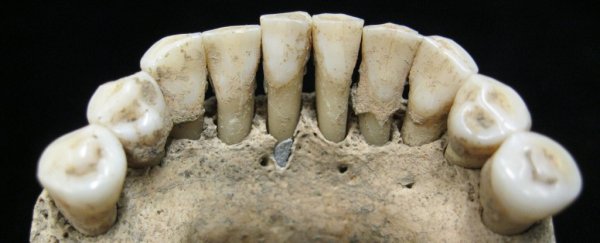A tiny fragment of lapis lazuli pigment, discovered in the fossilised teeth of a medieval woman, is now challenging some of our most basic assumptions about the history of book production.
Before the dawn of the 15th century, scribes and artists in Europe who wrote and illustrated religious manuscripts were often too modest to seal their works with a signature.
Because female names are especially scarce among the surviving texts from this period, historians have long assumed that male monks were the primary producers of these intricately illustrated manuscripts.
Only recently has this belief been re-examined. Along with a growing body of research, a new discovery adds even more evidence that female monastics were not only literate, but were also prolific producers and consumers of books during the Middle Ages.
Hidden within the dental plaque of a middle-aged woman buried at an all-female monastery in Germany sometime around 1000-1200 CE, researchers have now found a clue that speaks volumes: a hint of ultramarine ink.
 (Monica Tromp)
(Monica Tromp)
After analysing the remains, researchers from the University of York and the Max Planck Institute think this mysterious woman was probably an experienced painter of richly illuminated religious texts.
"Based on the distribution of the pigment in her mouth, we concluded that the most likely scenario was that she was herself painting with the pigment and licking the end of the brush while painting," explains one of the authors, Monica Tromp, a microbioarchaeologist at the Max Planck Institute.
The authors write that this represents the "earliest direct evidence that religious women in Germany used ultramarine pigment."
Yet as impressive as this sounds, to truly understand the immensity of this discovery, we must look back several hundred years, to a time when lapis lazuli was commonly ground and purified, creating a brilliant ultramarine pigment.
Mined from a single region in Afghanistan and traded over thousands of kilometres throughout Europe and Asia, this luxury good was enormously expensive, and the luminescent ink was almost exclusively reserved for the most luxurious manuscripts - not to mention the most exceptional scribes and painters.
Apparently, that includes this paintbrush-licking female painter.
"Here we have direct evidence of a woman, not just painting, but painting with a very rare and expensive pigment, and at a very out-of-the way place," says senior author, Christina Warinner, a researcher in the evolution of ancient microbiomes at the Max Planck Institute.
 (Christina Warinner)
(Christina Warinner)
The authors' conclusion is supported by a growing body of evidence that suggests religious women in Germany and Austria played a particularly active role in book production. In fact, some historians now think that women in these regions were working as scribes and illustrators as early as the late 8th century.
A community of nuns at a monastery in Salzburg, for example, copied more than 200 surviving books from the 12th-century collection. And a single female scribe living in 12th-century Bavaria is thought to have produced more than 40 books alone.
Nevertheless, because signatures are scarce and few of these texts survive, the authors note that "female scribes remain poorly visible in the historical record, and it is likely that most of their scribal work has gone unrecognised."
Hopefully, these impressive women won't be neglected forever. If more of this ultramarine pigment can be found in other archaeological finds, historians may finally have a method for identifying those unnamed artists and scribes who played such an active role in medieval book production.
"This woman's story could have remained hidden forever without the use of these techniques," says Warinner.
"It makes me wonder how many other artists we might find in medieval cemeteries - if we only look."
This study has been published in Science Advances.
